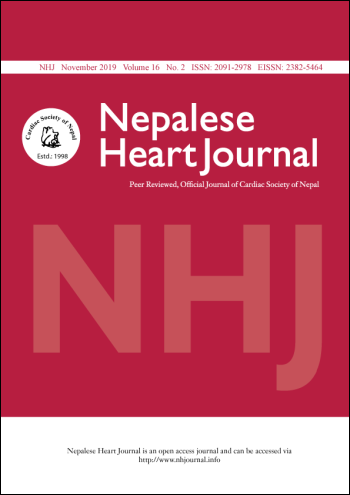Study of clinical profile and indications of Permanent Pacemaker Insertion in Nepali population presenting to tertiary care centre in Nepal
DOI:
https://doi.org/10.3126/njh.v16i2.26317Keywords:
Complete Heart Block, Permanent Pacemaker Insertion, Sick Sinus SyndromeAbstract
Background and Aims: Although pacemaker implantation has been done regularly in Nepal for the last 20 years, there is no large scale published data of pacemaker implantations. Manmohan Cardiothoracic Vascular and Transplant Centre (MCVTC) have been providing uninterrupted permanent pacemaker implantation services since its inception. This led us an opportunity to report the data regarding permanent pacemaker implantations in MCVTC.
Methods: Hospital records of all patients who had undergone PPI at MCVTC between Shrawan 2070 – Ashad 2075/ July 2013- June 2018 (5 years) were searched for and all available data were retrospectively analyzed.
Results: A total of 277 cases underwent PPI at MCVTC in 5 years. Out of these 165 (59.5%) were male with male to female ratio of 1.47. The mean age was 65.82±16.10 years with 3 (1.1%) cases of <20 years of age and almost 70% of cases aged >60 years. Dual chamber units were implanted in 49 (17.7%) cases. Only 13 women (11.6%) received dual chamber pacemaker compared with 36 men (21.8%) (P = 0.029). The most common indication for PPI was complete atrioventricular block 165 (59.6%) followed by sick sinus syndrome 65 (23.5%). Hypertension 84 (30.3%) was the most common co morbidity present. Complication occurred in 5.4% of cases with wound infection as commonest complication and single mortality due to postoperative complications post-RV repair.
Conclusion: Single chamber pacemaker was the most commonly used pacemaker. Dual chamber pacemaker was more common in younger patients. Complete heart block was the most common indication. Permanent pacemaker insertion was effective and relatively safe procedure in MCVTC with few complications.
Downloads
Downloads
Published
How to Cite
Issue
Section
License
This license enables reusers to distribute, remix, adapt, and build upon the material in any medium or format, so long as attribution is given to the creator. The license allows for commercial use.




